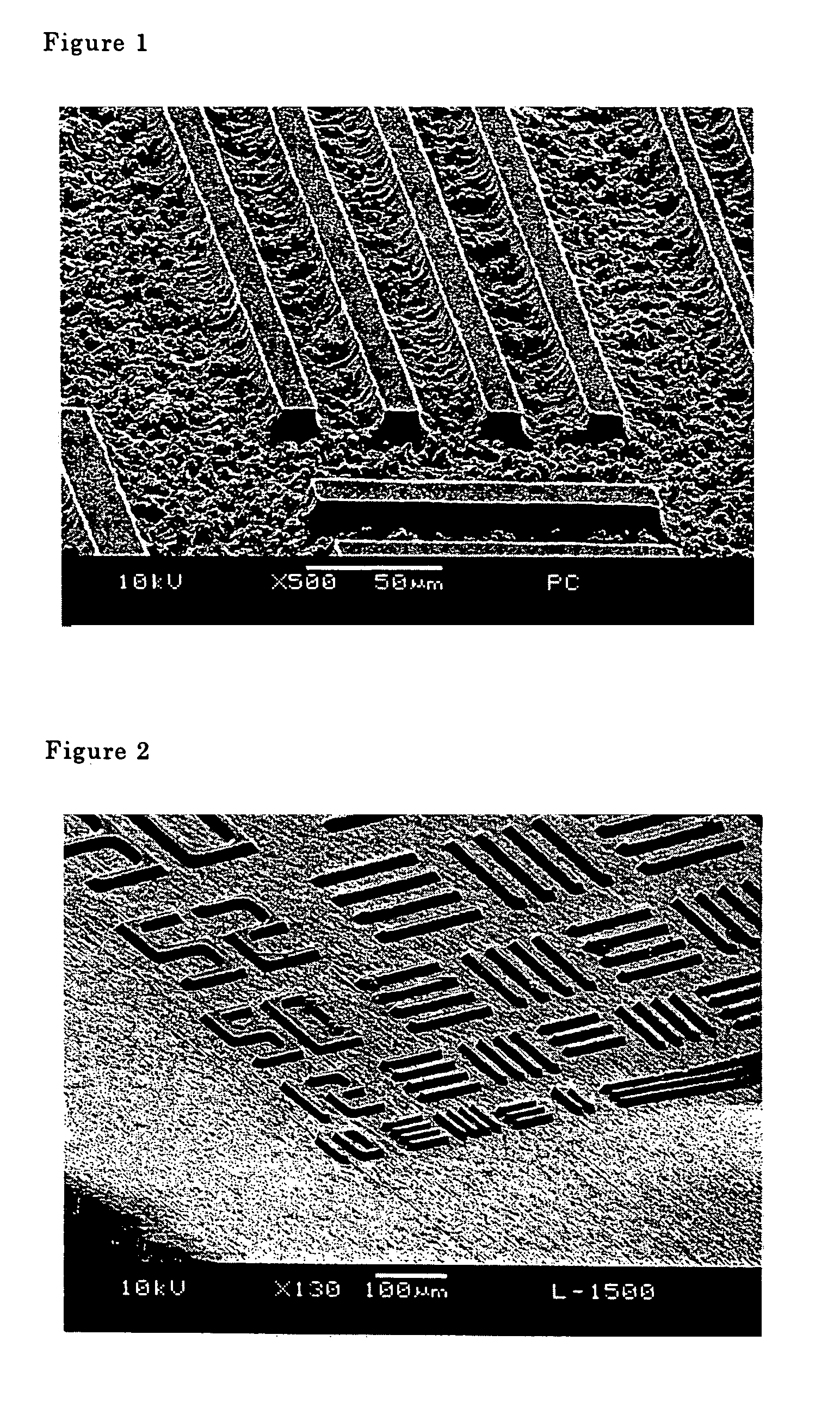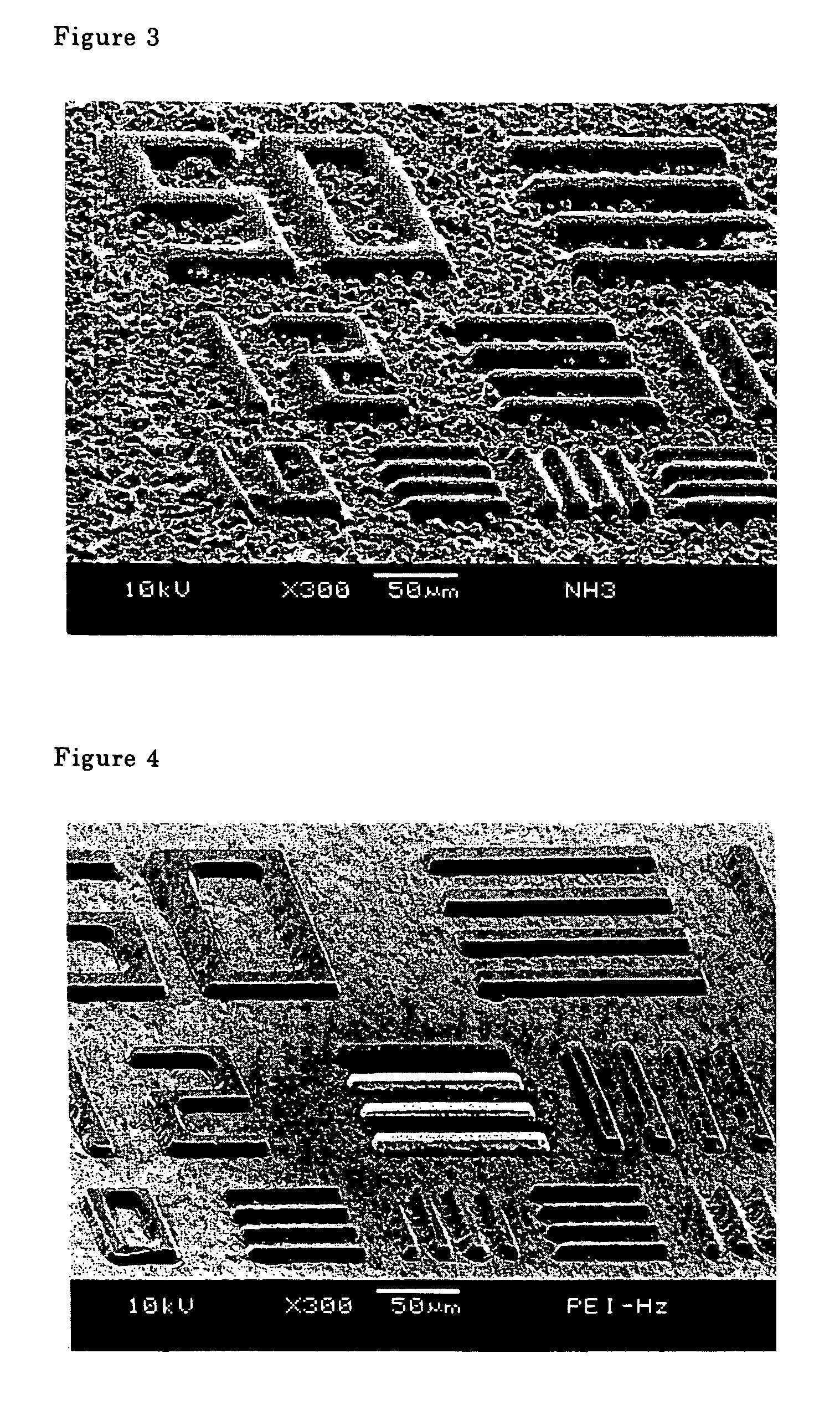Method for forming image through reaction development
a technology of reaction development and photoresist, which is applied in the field of photoresist technology, can solve the problems of low molecular weight polymers and dissolution, and achieve the effect of low environmental load
- Summary
- Abstract
- Description
- Claims
- Application Information
AI Technical Summary
Benefits of technology
Problems solved by technology
Method used
Image
Examples
example 1
[0054]Twenty grams of bisphenol A type polycarbonate (henceforth referred to as PC) in the form of pellets was added to a 200 ml pear-shaped flask with 60 g of NMP. The contents were mechanically agitated at 180° C. to heat and dissolve the solids to obtain an NMP varnish of PC (the solids content: 25% by weight). Next, 20 g of the varnish was added to a solution obtained by dissolving 1.5 g of diazonaphthoquinone type photo sensitizer PC-5 (Toyo Gosei, 1,2-naphthoquinone-2-diazide-5-sulfonic acid p-cresol ester) in 5 g of NMP, and a photo resist formulation (a light sensitive PC composition) was prepared by agitating the mixture with a stirrer for about an hour at room temperature. This solution was spin coated (600 rpm / 10 seconds+1,000 rpm / 30 seconds) on a 35 μm electrolytic copper foil (on shiny or matte surface). The coating was pre-baked (90° C. / 10 minutes) using a far infrared hot air circulating type dryer to obtain a photosensitive PC coating film 15 μm thick. An ultraviolet...
example 2
[0055]Polyarylate (Unitika, U polymer, henceforth referred to as PAr) was used in place of PC, but the same operations described in Example 1 were used to prepare a photo resist formulation.
[0056]This photo resist formulation was used to execute the same operations described in Example 1 to obtain a photosensitive coating film, 15 μm thick. Next, a developing solution comprising 400 g of ethanolamine, 100 g of NMP and 100 g of ion exchanged water was used, and the image was developed for twelve minutes at 45° C. The same operations described in Example 1 were conducted to obtain a positive image. The degree of resolution was 10 μm in terms of a line-and-space pattern. The SEM photograph of this photo resist is shown in FIG. 2.
example 3
[0057]The same operations described in Example 1 were used to prepare a photo resist formulation (PC).
[0058]This photo resist formulation was used to execute the same operations described in Example 1 to obtain a photosensitive coating film 14 μm thick. An exposure rate of 2,000 mJ / cm2 was used, and a developing solution comprising 100 g hydroxylamine, 100 g of NMP and 100 g of ion exchanged water was used to develop an image for seven minutes at 41° C. The same operations described in Example 1 were conducted to obtain a positive image. The degree of resolution was 20 μm in terms of a line-and-space pattern.
PUM
| Property | Measurement | Unit |
|---|---|---|
| thickness | aaaaa | aaaaa |
| thickness | aaaaa | aaaaa |
| temperature | aaaaa | aaaaa |
Abstract
Description
Claims
Application Information
 Login to View More
Login to View More - R&D
- Intellectual Property
- Life Sciences
- Materials
- Tech Scout
- Unparalleled Data Quality
- Higher Quality Content
- 60% Fewer Hallucinations
Browse by: Latest US Patents, China's latest patents, Technical Efficacy Thesaurus, Application Domain, Technology Topic, Popular Technical Reports.
© 2025 PatSnap. All rights reserved.Legal|Privacy policy|Modern Slavery Act Transparency Statement|Sitemap|About US| Contact US: help@patsnap.com



